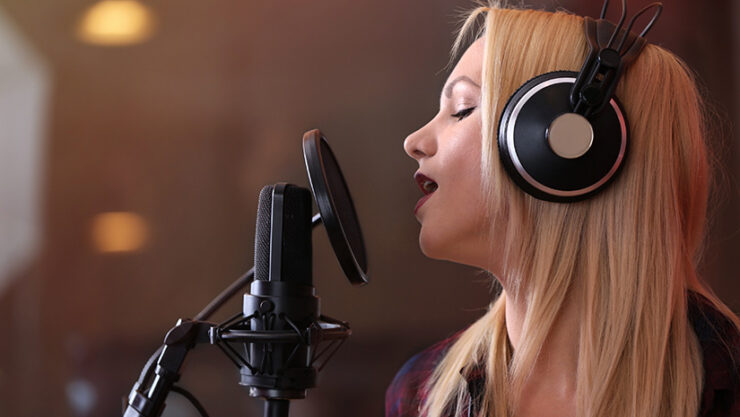Ever wondered what separated the cardioid and super cardioid microphone from each other? Finding out the difference between these two microphones isn’t as simple and easy as most people think it to be, but we are here to help. What’s the difference between cardioid and super cardioid microphone? Read this post to find out.
Without wasting your time, the polar pattern remains the significant difference between the cardioid and super cardioid microphones. If you are still new to microphones, you might wonder a polar pattern means. Polar patterns implies the degree of sensitivity which is relative to the angle or direction where sound gets to the microphone.
Content Navigation
What’s The Difference Between Cardioid And Super Cardioid Microphone?

One fact about cardioid microphones is they are designed to be sensitive to sounds that are produced right in front of them, making them less sensitive to sounds that are produced behind them. The way they receive sounds also extends to both sides of the microphone, making it possible for this cardioid microphone to house two singers.
It boasts of having a multi-pattern technique that makes it possible for it to accommodate two singers and a vocalist, but what we want you to note about cardioid microphones is they are designed to focus on the sounds produced by or at a single source. It is designed to reduce the rate it picks up sounds from its rear and sides.
One advantage of the cardioid polar pattern is it is going to grab sounds that comes from a single singer with ease and clarity, while sounds produced by the monitor and instruments behind it gets ignored. Now, there are certain places where you can make use of the cardioid microphone type, and these places are listed below;
- Solo vocals
- Stereo XY milking
- Live performance
When you contrast between a cardioid and super cardioid microphone, it is easy for you to tell that a super cardioid microphone has a tighter pickup angle that the cardioid microphone. The super cardioid microphone is designed to function as the opposite of the cardioid microphone, and what do we mean by this?
This simply means that he super cardioid microphone is designed to pick up sounds more from its rear than the sounds coming directly in front of it. It is the most sensitive microphone to on axis sounds, and it also boasts of offering the best side rejection function compared to the cardioid microphone.
Furthermore, another fact about the super cardioid microphone is it will provide users with the best in sound isolating functions. This means it is going to offer protection against sounds coming from instruments and noise in the surrounding, but the vocalist has to remain in the same position while singing for them to be clearly heard.
Below are the best places or conditions you can work with using the super cardioid microphone;
- Television shows and for movies since they are capable of picking up directional sounds
- They can also be used for live performances since they are the best at offering directional pickup functions
Taking you back a bit, it is very useful that you know that cardioid and super cardioid are simple terms used in explaining different microphone types. This piece of information we just shared about these microphones should come in handy if you are new to working with microphones, so you do not have to get confused about these terms.
It is very important that you understand how these microphones are designed to function separately so you do not end up confusing one microphone for the other. Having a clear knowledge of both microphones makes it simple for you to walk into any market or go online to shop for anyone of your choice.
Trust me when i say knowing what features they come with or what their abilities are makes it possible for you to make up your mind on which one of them you want to work with. Just like we mentioned earlier, polar patterns is what differentiates both microphones, but you should know where both microphones function at their best.
Read This – Why Is No Sound Coming From My Speaker
Cardioid Microphone Drawbacks
One of the drawbacks that comes with making use of the cardioid microphone is how there is a drop in frequency sensitivity, which causes sounds to go towards the sides and off axis. This makes it difficult for inexperience singers to work with this microphone as they might tend to move their head around a lot when singing on stage.
Proximity issues is yet another problem that comes up when working with a cardioid microphone, and it has the tendency of ruining a recording especially when you do not combine a cardioid microphone with a pop filter.
Super Cardioid Microphone Drawbacks
The fact that this microphone only picks up sounds from its axis is its major downside, and this makes it difficult for this microphone to easily pickup sounds from the side? This means you cannot make use of a super cardioid microphone in making omni-directional recordings as sounds produced will be very low and poor.
Should You Go For The Cardioid Or Super Cardioid Microphone?

Having a good understanding of the polar pattern that will be perfect for your needs and expectations then you will be able to picture yourself singing on stage or recording with the right microphone. You can be able to achieve the sounds you desire with ease if you can identify the strengths and weakness of both microphones.
Minimizing the capturing of unwanted sounds and focusing on how to position your microphone will be simple once you have a very good understanding of the polar pattern you would love to work with. A cardioid microphone will be the best choice for you if you are going to spend more time singing on stage.
This is because it will cut down on how you pick up sounds from instruments behind you. Recording vocals with impressive detail can be achieved when you make use of the super cardioid microphone, and it can get this done without obtaining any form of feedback from your environment.
Frequently Asked Questions
Is Cardioid A Condenser Microphone?
- What you actually need to know is the cardioid microphone is not a condenser or dynamic microphone, as cardioid has to be with a polar pattern, while condenser and dynamic are types of microphones.
How Close Should A Microphone Be To The Mouth?
- Your microphone should be kept close to the mouth as possible, and this is required if you are going to pick up sounds from the microphone. The microphone should be positioned about six to twelve inches from the mouth for it to be able to pickup sounds.
Do Cardioid Microphone Need Phantom Power?
- Cardioid and dynamic microphone do not require phantom power for them to function, and they do not need any form of power at the same time.
Trendy Post – What Microphone Do Celebrities Use To Record
Conclusion
We have provided you with all you need to know about these microphones, and everything we have said should equip you and get you prepared when you want to make a right choice for you. Do not forget to take the drawbacks we mentioned into consideration, as it will help you figure out which of the microphones you can deal with.

